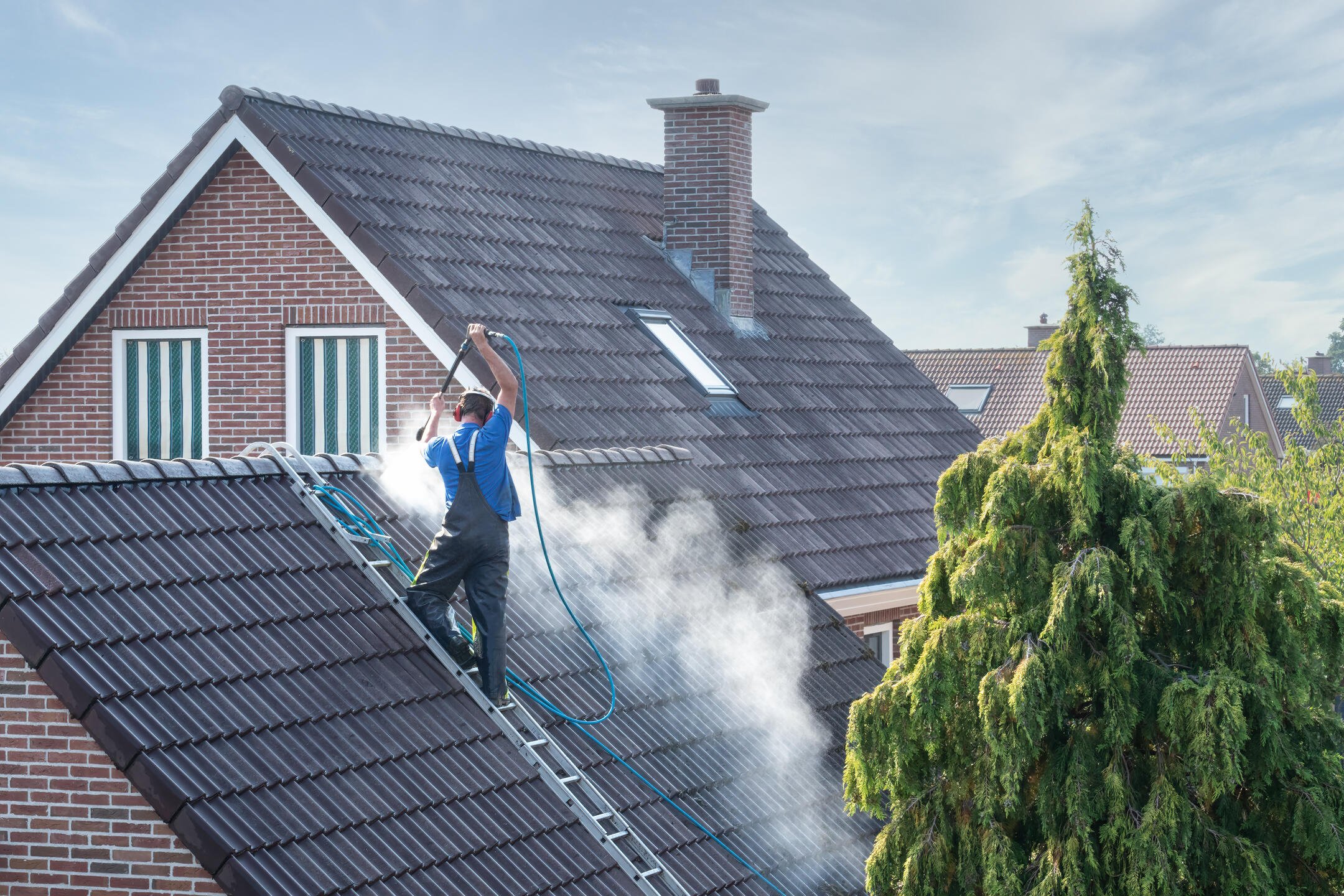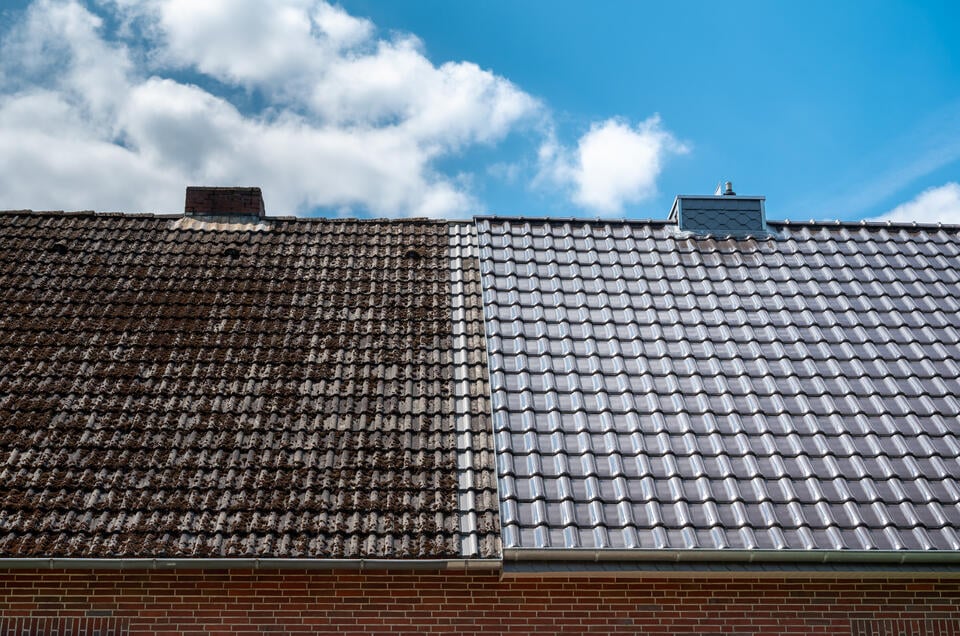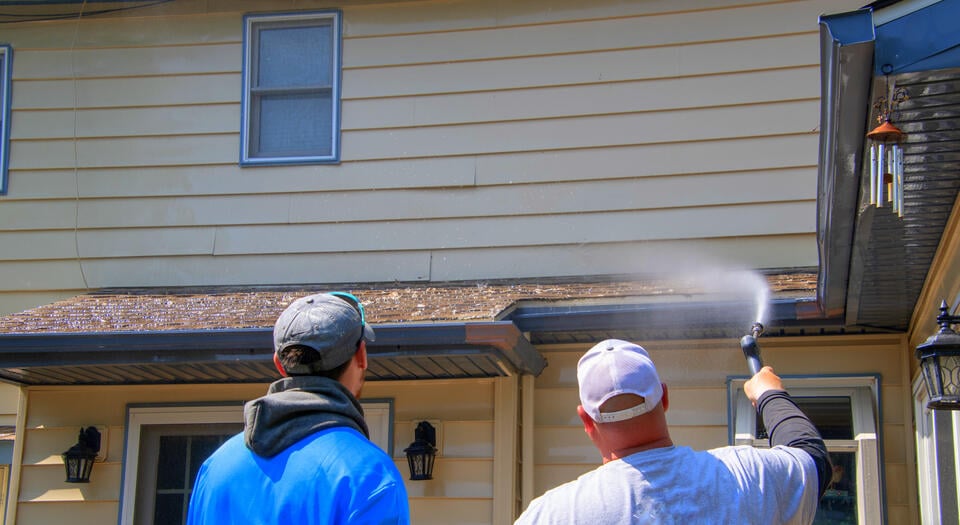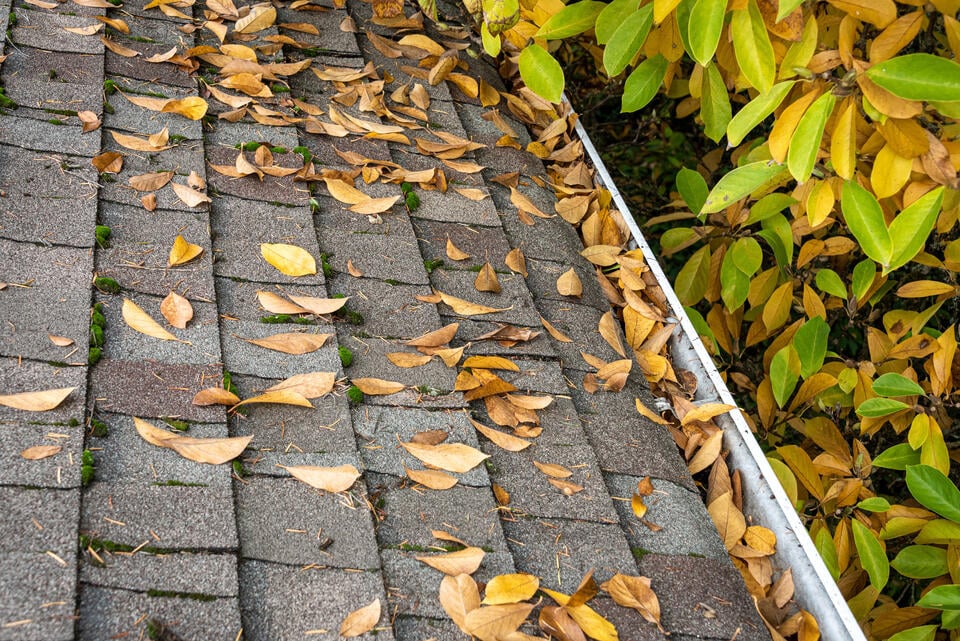
Roof Washing 101: How to Keep Your Roof Clean and Protected
Your roof is one of the most important parts of your home. It protects you from the elements, ensures your safety, and helps maintain the value of your property. But how often do you think about keeping it clean? Roof washing isn’t just about aesthetics—it’s about extending your roof’s life and preventing costly repairs down the line. Here’s what you’ll learn in this guide:
- Why roof washing is essential
- Common roof cleaning methods
- A step-by-step guide to keeping your roof clean
- When to call the professionals
Why Roof Washing is Essential

A clean roof is more than just a visual upgrade—it provides critical protection and maintenance benefits for your home. Dirt, moss, algae, and debris can do more than make your roof look old and unkempt. They can lead to severe structural damage if not handled properly.
The benefits of roof washing:
- Prolonged Roof Lifespan: Regular washing prevents mold and moss buildup that can cause shingles to deteriorate.
- Improved Energy Efficiency: A clean roof reflects sunlight better, reducing heat absorption and potentially lowering energy bills.
- Cost Savings: Preventing grime and growth buildup can save you thousands in expensive repair or replacement costs.
- Enhanced Curb Appeal: A spotless roof boosts the overall appearance and value of your home.
Neglecting roof cleaning may result in clogged gutters, leaks, and unsightly stains. Whether you’re preparing your home for sale or just want a functional roof for years to come, regular washing is non-negotiable.
Common Roof Cleaning Methods

Keeping your roof clean is crucial to maintaining its longevity and appearance. There are several ways to clean a roof, each tailored to specific types of materials and levels of debris or growth. Choosing the right method is essential to avoid unnecessary damage and ensure your roof remains in good condition.
Soft Washing
Soft washing is a gentle yet effective method of cleaning a roof. It involves the use of a low-pressure water spray combined with specially formulated cleaning solutions designed to break down dirt, algae, lichen, and moss without harming the roofing material. This method is especially suited for delicate materials like asphalt shingles, wooden shakes, and clay tiles, as it minimizes the risk of dislodging or degrading them. Soft washing is also an eco-friendly option, as many cleaning solutions are biodegradable and safe for plants and animals. However, it’s important to hire professionals or follow proper guidelines to ensure the solution is applied evenly and rinsed thoroughly to prevent residue buildup.
Pressure Washing
Pressure washing uses a high-pressure water spray to blast away tough stains, dirt, and debris. It is particularly effective for durable roofing materials such as metal, concrete tiles, or slate. However, this method requires caution, as excessive pressure can strip paint, loosen tiles, or cause water to seep underneath the roofing material, leading to leaks. For this reason, pressure washing is not recommended for more fragile materials like shingles or wood shakes. It’s best to leave this method to professionals who know how to adjust the water pressure to suit the roof type and ensure thorough cleaning without causing damage. Additionally, detergents or cleaning agents can be combined with the high-pressure water to target specific grime or mold effectively.
Manual Cleaning
Manual cleaning is a labor-intensive but precise method for removing debris, moss, or algae from your roof. It involves using specialized brushes, brooms, or scrapers to gently lift unwanted growth without causing damage to the roofing material. This approach is particularly useful for smaller roofs or when dealing with isolated patches of moss or dirt. Manual cleaning allows for better control and minimizes the risk of displacing tiles or shingles compared to mechanical methods. However, it can be time-consuming and requires proper safety measures, such as harnesses and ladders, to prevent accidents. Additionally, manual cleaning should be performed with tools that are specifically designed for roof maintenance to avoid scratches or wear on the surface.
Pro Tip:
Before choosing a roof cleaning method, always consider the type of roofing material and consult the manufacturer’s guidelines. Using the wrong cleaning technique or tools can void warranties, weaken the roof’s structural integrity, or lead to costly repairs. If you’re unsure, it’s always a good idea to consult with a roofing professional to evaluate your roof’s condition and recommend the safest and most effective cleaning method. Regular maintenance, such as periodic inspections and gentle cleanings, can help extend the life of your roof and prevent the buildup of damaging elements.
6 Steps to Keep Your Roof Clean

Maintaining your roof doesn’t have to be overwhelming. Keeping your roof in good shape not only enhances your home’s curb appeal but also extends its lifespan. Follow these expanded steps to ensure your roof stays clean and damage-free:
1. Inspect Your Roof Regularly
Make it a habit to check your roof at least twice a year, preferably in the spring and fall. Look for visible signs of dirt, moss, algae, or lichen, as these can cause long-term damage if left untreated. Pay attention to cracked, curled, or missing shingles, as well as leaks or water stains inside your home, which may indicate roof damage. Early detection can save you from costly repairs later on. Consider using binoculars to safely inspect your roof from the ground or hire a professional for a closer look.
2. Remove Debris
Debris such as fallen leaves, twigs, and branches can trap moisture on your roof, creating a breeding ground for mold, mildew, and rot. Use a leaf blower, soft broom, or roof rake to gently clear debris without damaging shingles. Avoid using sharp or heavy tools that could scrape or puncture your roof. For tough-to-reach areas, consider hiring a professional. Keeping your roof free of debris will help maintain proper water drainage and prevent long-term damage.
3. Use a Roof Cleaner
Choose a cleaning solution specifically designed for your roof’s material—whether it’s asphalt shingles, clay tiles, or metal roofing. Opt for an eco-friendly cleaner that won’t harm plants, pets, or nearby water sources. Apply the cleaner evenly using a spray applicator or soft brush, and allow it to sit for the recommended time to break down dirt, moss, and algae. Avoid using harsh chemicals like bleach unless absolutely necessary, as they can damage your roof and surrounding landscaping.
4. Rinse with Care
After applying your roof cleaner, rinse your roof thoroughly to wash away loosened dirt and grime. Use a garden hose fitted with a spray nozzle to direct water gently down the slope of your roof. Avoid using a pressure washer, as the high-pressure water can dislodge shingles, damage protective coatings, or force water underneath your roofing materials, leading to leaks. A soft washing technique ensures your roof stays intact while getting it clean.
5. Trim Overhanging Branches
Overhanging tree branches can create shade, which promotes moss and algae growth on your roof. They also drop leaves and debris, which can clog gutters and trap moisture. Use a pair of long-handled pruning shears or hire a professional arborist to cut back branches that hang over your roof. Keeping the area above your roof clear not only reduces debris but also protects your roof from potential damage caused by falling branches during storms.
6. Keep Gutters Clean
Clogged gutters can cause water to back up and pool on your roof, leading to leaks, mold growth, and even structural damage. Regularly clean your gutters to ensure proper drainage. Remove leaves, dirt, and debris using a gutter scoop or gloved hands, and flush the gutters with water to clear out any remaining residue. Consider installing gutter guards to reduce the frequency of cleaning and prevent debris from accumulating in the first place. Clean gutters help keep your roof, foundation, and home in excellent condition.
When to Call the Professionals
While some roof washing tasks can be done on your own, others require the expertise of professionals. Here’s when to consider bringing in the experts:
- You notice extensive moss, algae, or mold growth that won’t go away with DIY methods.
- You have a steep or multi-story roof that’s unsafe to clean yourself.
- You’re unsure of your roof type or how to clean it safely.
- You don’t have the proper tools, like soft washing equipment or specialized cleaning solutions.
At Better Way Roofing, we provide effective and safe roof maintenance services tailored to your home. Our experienced team knows precisely how to handle all types of roofs, ensuring they’re cleaned and protected without risk of damage. Plus, we offer free estimates on all our services so you can make an informed decision.
Professional Roof Washing & Maintenance Services
At Better Way Roofing, we take pride in delivering top-notch roof washing and maintenance services that keep your home safe and looking its best. Our skilled team is trained to handle even the toughest challenges, ensuring your roof is treated with care and expertise. With a commitment to customer satisfaction, we use industry-leading tools and techniques to provide exceptional results every time. Don’t leave the health of your roof to chance—trust the professionals who prioritize quality and safety. Contact us today for your free estimate and see why so many homeowners choose Better Way Roofing for their roofing needs!
